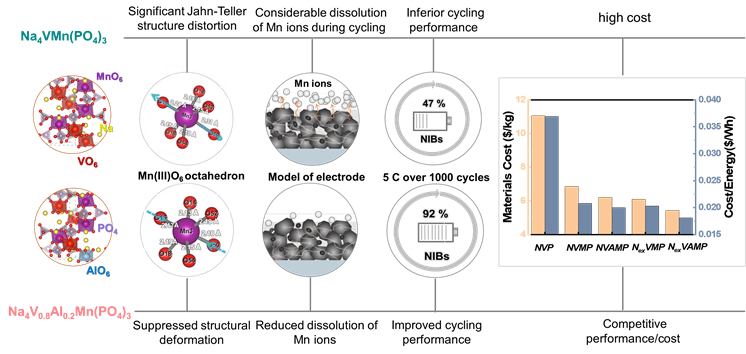A research group led by Prof. ZHAO Junmei from the Institute of Process Engineering (IPE) of the Chinese Academy of Sciences developed a novel vanadium-poor and manganese-rich phosphate cathode with better electrochemical performance for Na-ion batteries.
The study was published in ACS Energy Letters on Dec. 3.
This work addresses the crucial issues on how to effectively suppress the Jahn-Teller distortions of Mn3+, meanwhile minimizing the cost of raw materials and enhancing the electrochemical performance in the Mn-rich phosphate cathodes.
The so called Jahn-Teller distortion means a geometric structure deformation of MnO6 octahedron, resulted from the shrinkage or elongation of the O-Mn-O bond when Mn is in the high-spin Mn3+ oxidation state. Such a structural distortion is usually accompanied by the serious structure degradation and sluggish kinetics, finally leading to the inferior electrochemical performance.
Mn-based phosphate cathodes are promising due to low cost and high voltage, particularly the Mn-rich NASICON structure. Thus, it's significant to effectively suppress the undesired Mn3+ Jahan-Teller effect in the Mn-rich phosphate cathodes.
In this study, the researchers designed the Al3+ as a stabilizer for selective replacement of V instead of Mn to tune the crystal structure of Mn-based Na4VMn(PO4)3 system. DFT calculation affirmed that the structural distortions and the dissolution of Mn ions were effectively suppressed due to enhanced ionic-covalent character after Al substitution.
The resulting Na4V0.8Al0.2Mn(PO4)3 achieved a capacity retention over 92% after cycling 1000 times at 5 C, which was far superior to that (only 47%) of Na4VMn(PO4)3 cathode.
Benefiting from the synergistic effects among V, Al and Mn multi-elements, the Na4V0.8Al0.2Mn(PO4)3 exhibited enhanced ion diffusion ability and electronic conductivity. As a result, the Al incorporated Na4V0.8Al0.2Mn(PO4)3 cathode could deliver a superior rate capacity of 84 mA h g-1 at 40 C, even with the loading as high as 5.5 mg/cm2, significantly better than 62 mA h g-1 for Na4MnV(PO4)3.
Furthermore, a Mn-richer Na4.2V0.6Al0.2Mn1.2(PO4)3 was also proposed and developed as a viable candidate for Mn-richer phosphates cathodes.
Compared with Na3V2(PO4)3 and Na4VMn(PO4)3, the raw materials costs of Al incorporated Na4V0.8Al0.2Mn(PO4)3 cathode were reduced by nearly 44% and 10%, respectively. More impressively, those values for the Al substituted Mn-richer Na4.2V0.6Al0.2Mn1.2(PO4)3 could reach 50% and 20%, respectively.







